2017 MERCEDES-BENZ S-CLASS CABRIOLET trailer
[x] Cancel search: trailerPage 183 of 521
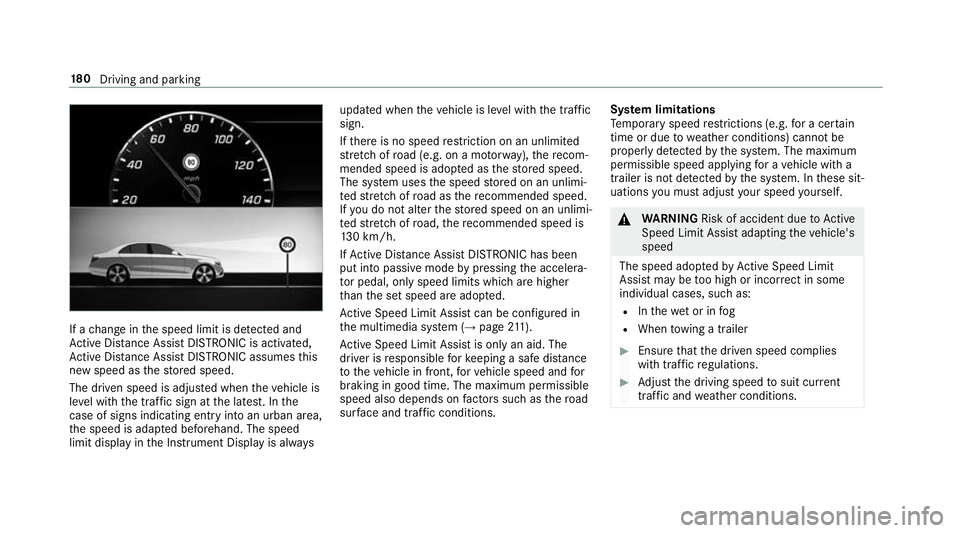
If
ac hang eint he speed limit is de tected and
Ac tiveD ista nce Assi stDISTRONI Cisactivated,
Ac tiveD ista nce Assi stDISTRONI Cassum esthis
ne ws peed as thes tore ds peed.
The driven speed is adjus tedw hen thev ehicle is
le ve lw itht he traf fics ignatt he latest. In the
case of signs indicating entr yintoanu rban area,
th es peed is adap tedb eforehand. The speed
limit displa yinthe Instrument Displa yisalways updated when
thev ehicle is le velw itht he tra ffic
sign.
If th er eisnos peedrestriction on an unlimi ted
st re tchofr oad (e.g. on amotorway),th er ecom‐
mended speed is adop tedast hestored speed.
The sy stem uses thes peed stored on an unlimi‐
te ds tret ch ofroad as ther ecommende dspeed.
If yo udon otalter thes tore ds peed on an unlimi‐
te ds tret ch ofroad, ther ecommende dspeed is
13 0k m/h.
If Ac tiveD ista nce Assi stDISTRONI Chasbeen
pu tint op assive mode bypressing thea ccelera‐
to rp edal, onl yspee dlimits which areh igher
th an thes etspeed ar eadop ted.
Ac tiveS peed Limi tAssistcan be configu redin
th em ultimedia sy stem (→ page211).
Ac tiveS peed Limi tAssistis onl yana id. The
driver is responsible fork eeping asafed ista nce
to thev ehicle in front, forv ehicle speed and for
braking in good time. The maximum permissible
speed also depends on factor ssuchast heroad
sur face and traf ficc onditions. Sy
stem limitations
Te mp orar yspeed restrictions (e.g .for ac ertain
tim eord uetowe ather conditions) canno tbe
proper lyde tected bythes ystem. The maximum
permissible speed applying forav ehicle wit ha
trailer is no tdetected bythes ystem. In these sit‐
uations youm usta djus tyour speed yourself. &
WARNING Risk of accident du etoActive
Speed Limi tAssistadaptin gthe vehicle's
speed
The speed adop tedbyA ctiveSpeed Limit
Assi stma ybet oo high or incor rect in some
individua lcases, su chas:
R Inthew etor in fog
R When towing atrailer #
Ensur ethat thed rive ns peed complies
wit htraffic regulations. #
Adjus tthe driving speed tosuit cur rent
traf fica nd weather conditions. 18 0
Driving and pa rking
Page 184 of 521
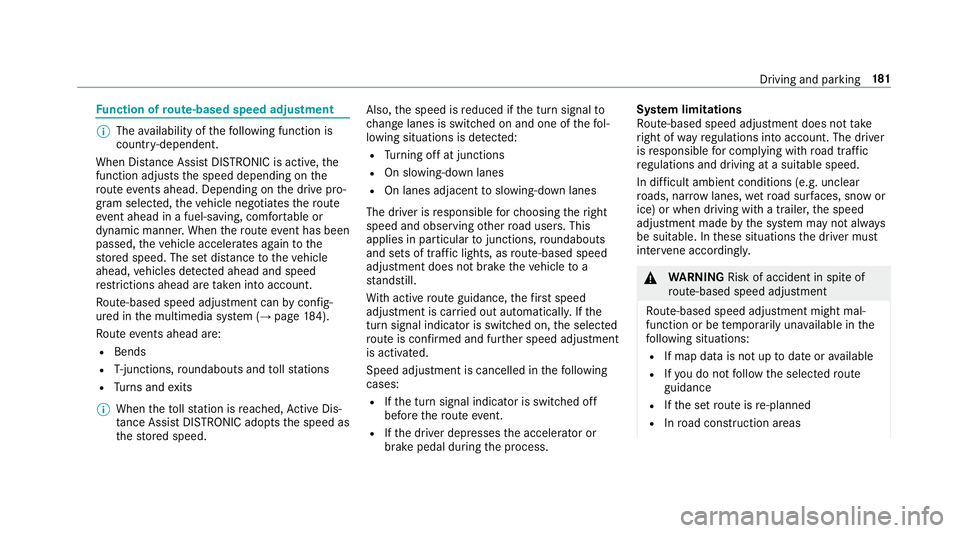
Fu
nction of route-base dspee dadjustment %
The availabilit yofthefollowing function is
countr y-dependent.
When Dis tance Assi stDISTRONI Cisactive,the
function adjusts thes peed depending on the
ro utee vents ahead. Depending on thed rive pro‐
gram selected, thev ehicle negotiates ther oute
eve nt ahea dinafuel-saving, com fortable or
dynamic manner .When ther out eevent has been
passed, thev ehicle accelerates again tothe
st ored speed. The se tdistan cetothev ehicle
ahead, vehicles de tected ahea dand speed
re strictions ahea daretake ni ntoa ccount.
Ro ute-based spee dadjustmen tcan byconfig‐
ured in them ultimedia sy stem (→ page184).
Ro utee vents ahea dare:
R Bends
R T-junctions, roundabout sand tollst ations
R Turnsa nd exits
% When thet oll statio nisr eached, ActiveD is‐
ta nce Assi stDISTRONI Cadoptst he speed as
th es tore ds peed. Also,
thes peed is reduced if thet urns ignal to
ch ang elane siss witched on and one of thef ol‐
lowing situations is de tected:
R Turning of fatjunctions
R On slowing-down lanes
R On lanes adjacent toslowing-down lanes
The driver is responsible forc hoosing ther ight
speed and observing other road users. This
applies in particular tojunctions, roundabouts
and sets of traf ficl ights, as route-based speed
adjustmen tdoes no tbrake thev ehicle to a
st andstill.
Wi th activ erout eguidance, thef irst speed
adjustment is car ried out automaticall y.Ifthe
tur ns igna lindica toriss witched on, thes elected
ro uteisc onfirm ed and fur ther speed adjustment
is activated.
Speed adjustmen tiscancelled in thef ollowing
cases:
R Ifth et urns ignal indicator is switched off
befor ethe routee vent.
R Ifth ed rive rd epresses thea ccelerator or
brak epedal during thep rocess. Sy
stem limitations
Ro ute-based spee dadjustmen tdoes no ttake
ri ght of wayregulations int oaccount.T he driver
is responsible forc omplying wit hroad traf fic
re gulations and driving at asuitable speed.
In dif ficul tambient conditions (e.g .unclear
ro ads, nar rowl anes ,wetroad sur faces, sno wor
ice )orw hend riving wi thatrailer ,the speed
adjustment made bythes ystem ma ynotalw ays
be suitable. In these situation sthe driver must
inter vene acco rdingly. &
WARNING Risk of accident in spi teof
ro ute-based spee dadjustment
Ro ute-based spee dadjustmen tmightm al‐
function or be temp oraril yunavailable in the
fo llowing situations:
R If map dat aisnotup todat eora vailable
R Ifyo udon otfollo wt he selected route
guidance
R Ifth es etrouteisr e-planned
R Inroad con stru ction areas Driving and pa
rking 181
Page 185 of 521
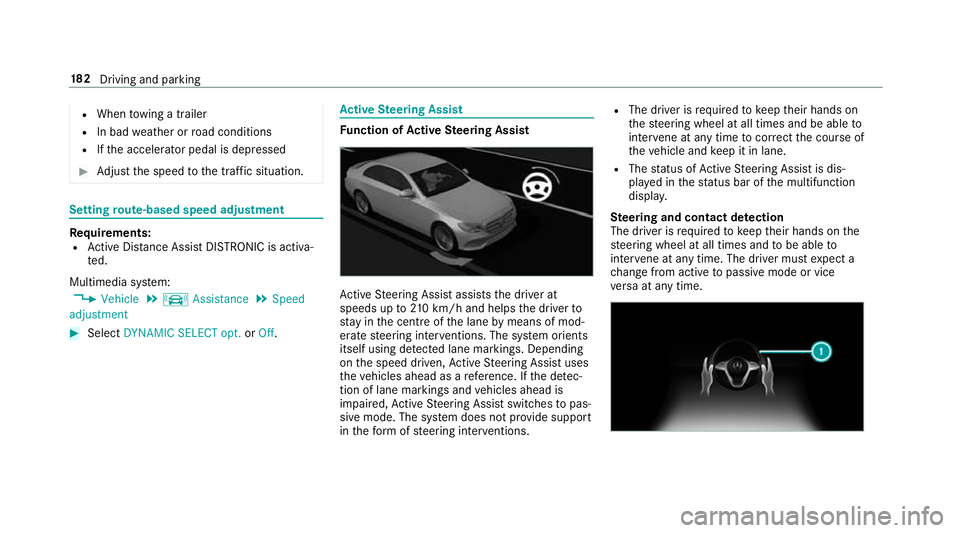
R
When towing atrailer
R In bad weather or road conditions
R Ifth ea ccelerator pedal is depressed #
Adjus tthe speed tothet raffic situation. Settin
groute-based speed adjustment Re
quirements:
R ActiveD ista nce Assi stDISTRONI Cisactiva‐
te d.
Multimedia sy stem:
, Vehicle .
k Assistance .
Speed
adjustment #
Select DYNAMIC SELECT opt. orOff. Ac
tiv eS teering Assist Fu
nction of Activ eS teering Assist Ac
tiveS teering Assis tassists thed rive rat
speeds up to210k m/h and helps thed rive rto
st ay inthec ent reofthel ane bymeans of mod‐
erat esteering inter ventions. The sy stem orients
itself using de tected lane markings .Depending
on thes peed driven, ActiveS teering Assis tuses
th ev ehicles ahead as areference. If thed etec‐
tio nofl anem arkings and vehicles ahead is
impaired, ActiveS teering Assis tswitches topas‐
siv em ode. The sy stem does no tprovide support
in thef ormofs teering inter ventions. R
The driver is requ ired tokeep their hands on
th es teering wheel at all times and be able to
inter vene at an ytime tocor rect thec ourse of
th ev ehicle and keep it in lane.
R The status of ActiveS teering Assis tisdis‐
pla yedint hestatus bar of them ultifunction
displa y.
Ste ering and contact de tection
The driver is requ ired tokeep their hands on the
st eering wheel at all times and tobe able to
inter vene at an ytime .The driver mu stexpect a
ch ang efroma ctivetop assivemode or vice
ve rsaata nytime. 18 2
Driving and pa rking
Page 201 of 521
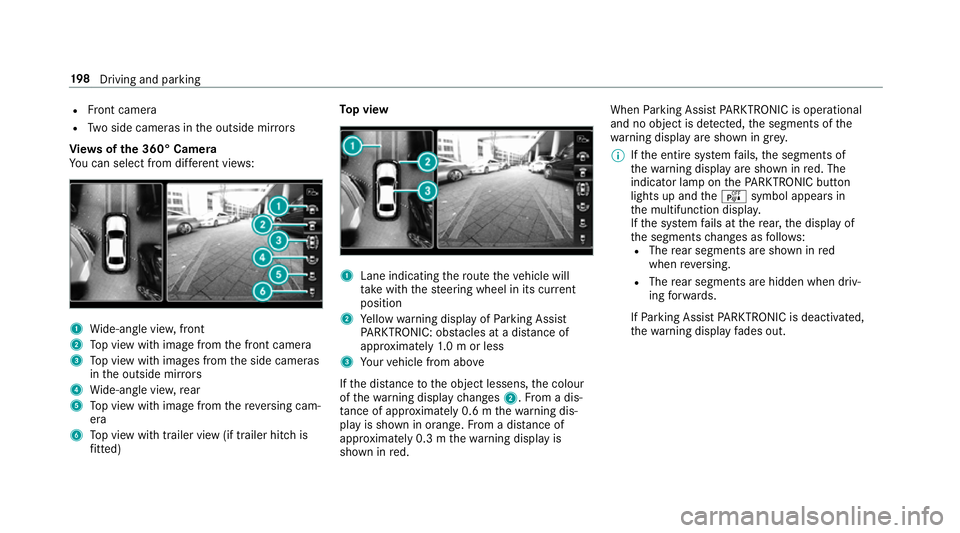
R
Front camera
R Twos ide cameras in theo utside mir rors
Vi ew soft he 360 °Camera
Yo uc an select from dif fere nt vie ws: 1
Wide-angle vie w,front
2 Topv ieww ithi mag efromt he front camera
3 Topv ieww ithi mages from thes ide cameras
in theo utside mir rors
4 Wide-angle vie w,rear
5 Topv ieww ithi mag efromt hereve rsing cam‐
era
6 Topv ieww itht railer vie w(if trailer hitc his
fi tted) To
pv iew 1
Lane indicating ther out ethe vehicle will
ta ke wit hthe steering wheel in its cur rent
position
2 Yello ww arning displa yofParking Assist
PA RKTRONIC: obstacles at adista nce of
appr oximatel y1.0morl ess
3 Your vehicle from abo ve
If th ed ista nce totheo bjec tlessens, thec olour
of thew arning displa ychanges 2.Fromad is‐
ta nce of appr oximatel y0.6mt hewarning dis‐
pla yiss hown in orange. From adistan ce of
appr oximatel y0.3mt hewarning displa yis
shown in red. When
Parking Assis tPARKTRONIC is operational
an dnoo bjectisd etected, thes egment softhe
wa rning displa yareshown in grey.
% Ifth ee ntir esystemf ails, thes egments of
th ew arning displa yareshown in red. The
indicator lam ponthePARKTRONI Cbutton
light supa ndthe é symbol appear sin
th em ultifunction displa y.
If th es ystemf ails at ther ear ,the displa yof
th es egment schanges as follo ws:
R The rear segment sareshown in red
when reve rsing.
R The rear segment sarehidde nwhen driv‐
ing forw ards.
If Pa rking Assis tPARKTRONIC is deactivated,
th ew arning displa yfades out. 19 8
Driving and pa rking
Page 204 of 521
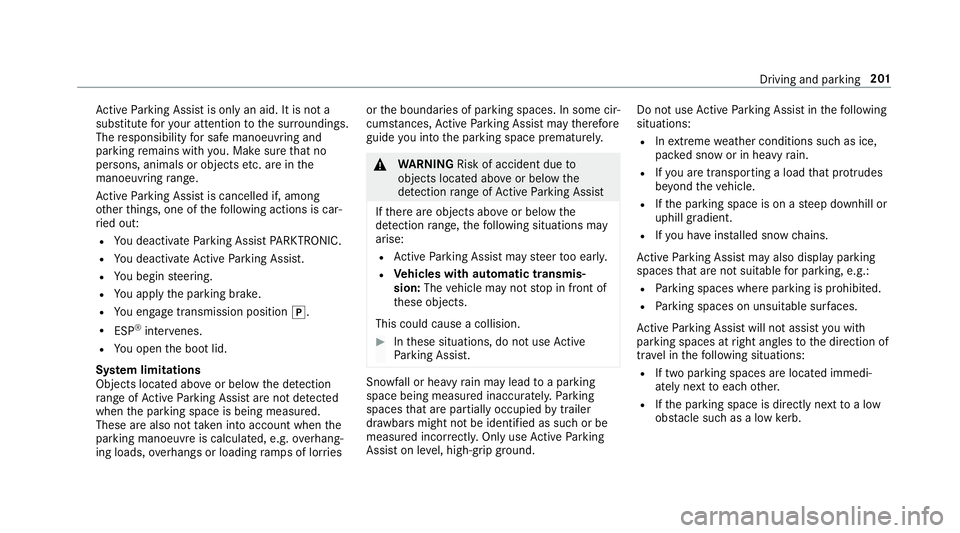
Ac
tiveP arking Assis tisonlyana id. It is no ta
substitut efor your attentio ntothe sur roundings.
The responsibility fors afem anoeuvring and
parking remains wit hyou. Mak esuret hat no
persons, animals or objectse tc. areinthe
manoeuvring range.
Ac tiveP arking Assis tiscancelled if, among
ot her things ,one of thef ollowing actions is car‐
ri ed out:
R Youd eactivat eParking Assis tPARKTRONIC.
R Youd eactivat eActiv eParking Assist.
R Youb egin steering.
R Youa ppl ythe parking brake.
R Youe ngaget ransmission position j.
R ESP ®
inter venes.
R Youo pen theb ootlid.
Sy stem limitations
Object slocated abo veor belo wthe de tection
ra ng eofA ctiveParking Assis tare notd etected
when thep arking space is being measured.
These ar ealso no ttaken in toaccount when the
parkin gmanoeuvr eiscalculated, e.g. overhang‐
ing loads, overhangs or loading ramp sofl orries or
theb oundaries of parking spaces. In some cir‐
cums tances, ActiveP arking Assis tmaytherefore
guide youi ntot he parking space prematurel y. &
WARNING Risk of accident du eto
object slocated abo veor belo wthe
de tection rang eofA ctiveParking Assist
If th er ea reobjects abo veor belo wthe
de tection range, thef ollowing situations may
arise:
R ActiveP arking Assis tmaysteer tooe arly.
R Vehicles with automatic transmis‐
sion: Thevehicle ma ynotstop in front of
th ese objects.
This could cause acollision. #
Inthese situations, do no tuse Active
Pa rking Assist. Sn
owfa ll or heavy rain ma ylead toap arking
spac ebeingm easured inaccuratel y.Pa rking
spaces that ar epartial lyoccupied bytrailer
dr aw bar sm ight no tbeidentified as suc horbe
measured incor rectly .Only us eActiv eParking
Assis tonlevel, high-grip ground. Do no
tuse ActiveP arking Assis tinthefollowing
situations:
R Inextreme weather condition ssuchasi ce,
pac keds noworinh eavyrain.
R Ifyo ua retransportin gaload that pr otru des
be yond thev ehicle.
R Ifth ep arking space is on asteep downhill or
uphill gradient.
R Ifyo uh avei nstalled sno wchains.
Ac tiveP arking Assis tmayalso displa yparking
spaces that ar enotsuitable forp arking, e.g.:
R Parking spaces wher eparkin gisp rohibited.
R Parking spaces on unsuitable sur faces.
Ac tiveP arking Assis twill no tassis tyou with
parking spaces at right angles tothed irection of
tr ave lint hefollowing situations:
R If tw oparkin gspaces ar elocated immedi‐
atel ynexttoe acho ther.
R Ifth ep arking space is directly next toalow
obs tacle su chasalow kerb. Driving and parking
201
Page 205 of 521
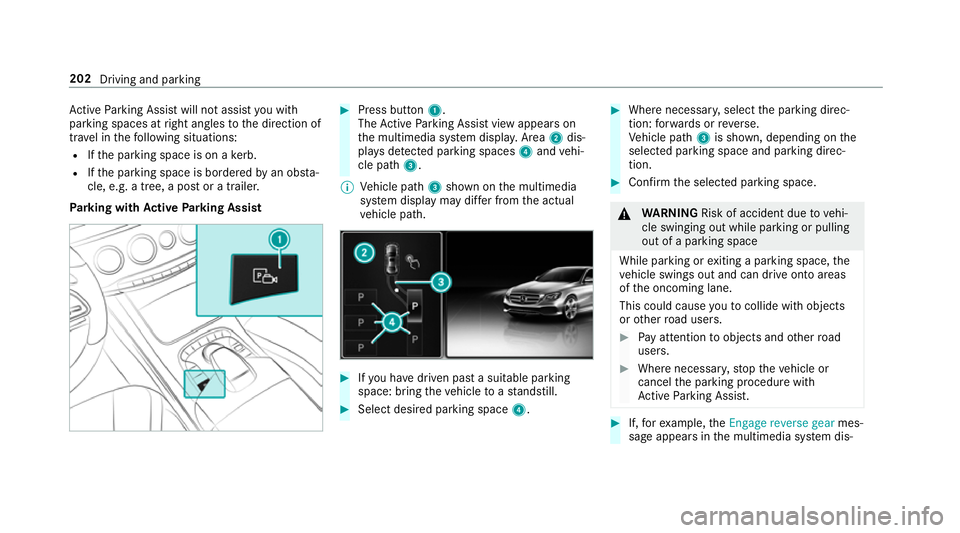
Ac
tiveP arking Assis twill no tassis tyou with
parking spaces at right angles tothed irection of
tra velint hefollowing situations:
R Ifth ep arking space is on akerb.
R Ifth ep arking space is bordered byan obs ta‐
cle ,e.g. atree, ap ostora trailer.
Pa rking wit hActive Parking Assist #
Press button 1.
The ActiveP arking Assis tviewa ppear son
th em ultimedia sy stem displa y.Area 2dis‐
pl ay sd etected parking spaces 4and vehi‐
cle path 3.
% Vehicle path 3shown on them ultimedia
sy stem displa ymaydifferf romt he actual
ve hicle path. #
Ifyo uh ave driven pas tasuitable parking
space: bring thev ehicle toas tandstill. #
Select desired parkin gspace 4. #
Wher enecessar y,select thep arking direc‐
tion :for wa rdsorr everse.
Ve hicle path 3is shown, depending on the
selected parking space and parking direc‐
tion. #
Confir mthe selected parking space. &
WARNING Risk of accident du etovehi‐
cle swinging out while parking or pulling
out of aparking space
While parking or exitin gap arkin gspace, the
ve hicle swings out and can driv eontoa reas
of theo ncoming lane.
This could cause youtoc ollidewitho bjects
or other road users. #
Paya ttention toobject sand other road
users. #
Wher enecessar y,stop thev ehicle or
cancel thep arking procedur ewith
Ac tiveP arking Assist. #
If,fore xamp le,the Engage reverse gear mes‐
sag eappear sinthe multimedia sy stem dis‐ 202
Driving and parking
Page 381 of 521
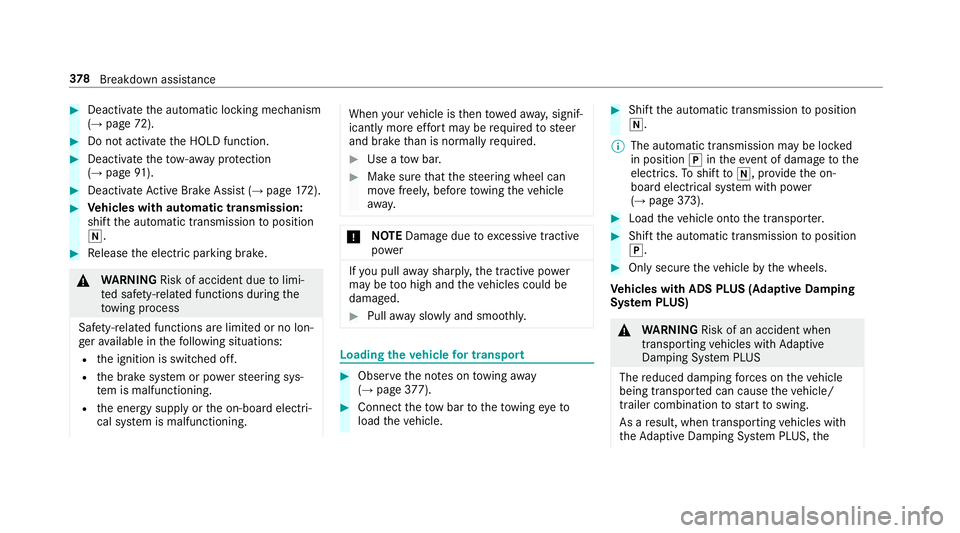
#
Deactivat ethe automatic locking mechanism
(→ pag e72). #
Do no tactivat ethe HOLD function. #
Deactivat ethe tow- aw ay protection
(→ pag e91). #
Deactivat eActiv eBrake Assi st (→pag e172). #
Vehicles with automatic transmission:
shif tthe automatic transmission toposition
i. #
Release thee lectric parking brake. &
WARNING Risk of accident du etolimi‐
te ds afet y-re lated function sduring the
to wing process
Saf ety-re lated function sarelimited or no lon‐
ge ra vailable in thef ollowing situations:
R thei gnition is switched off.
R theb rake system or po wersteering sys‐
te mism alfunctioning.
R thee nergy supply or theo n-boar delectri‐
cal sy stem is malfunctioning. When
your vehicle is then towe da way,signif‐
icantly mor eeffor tm aybe requ ired tosteer
and brak ethan is normall yrequired. #
Use atow bar. #
Mak esuret hat thes teering wheel can
mo vefreely ,befor etow ing thev ehicle
aw ay. *
NO
TEDama gedue toexcessiv etracti ve
po wer If
yo up ullaway sharpl y,thet ractiv epower
ma ybet oo high and thev ehicles could be
damaged. #
Pull away slowl yand smoo thly. Loading the
vehicl efor transport #
Obser vethen otes on towing away
( → pag e377). #
Con nect thet ow bar tothet ow ing eyeto
load thev ehicle. #
Shif tthe automatic transmission toposition
i.
% The automatic transmission ma ybelocked
in position jinthee vent of dama getothe
electrics. Toshif tto i,provide theo n-
boar delectrical sy stem wit hpower
( → pag e373). #
Load thev ehicle ont othe transpor ter. #
Shif tthe automatic transmission toposition
j. #
Onlysecur ethe vehicle bythew heels.
Ve hicles with ADSP LUS(Ad aptiv eDamping
Sy stem PLUS) &
WARNING Risk of an accident when
transporting vehicles wit hAdaptive
Damping Sy stem PLUS
The reduced damping forc es on thev ehicle
being transpor tedc an cause thev ehicle/
trailer combinatio ntostart to swing.
As aresult, when transporting vehicles with
th eA daptiv eDampin gSystemP LUS,the 378
Breakdown assis tance
Page 382 of 521
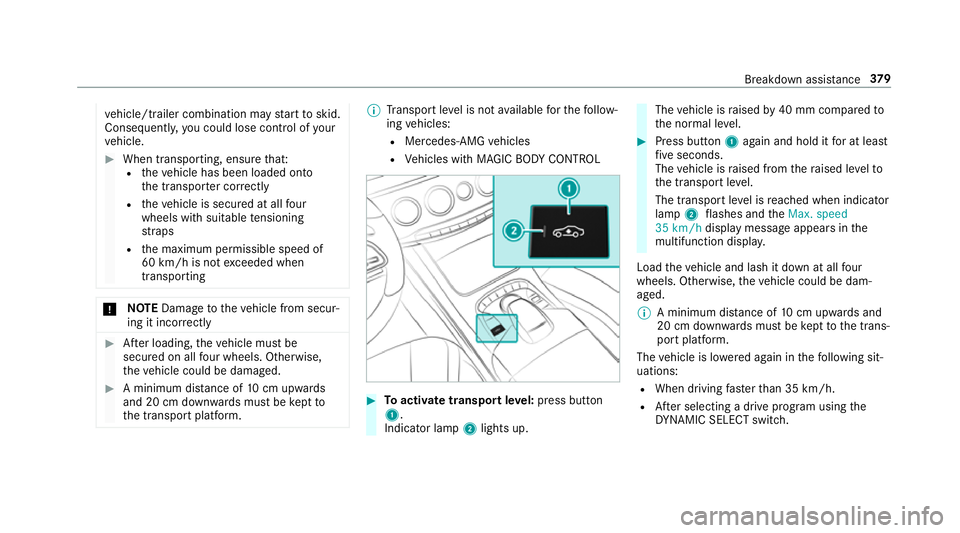
ve
hicle/trailer combination ma ystart to skid.
Consequentl y,yo uc ould lose cont rolofy our
ve hicle. #
When transporting, ensur ethat:
R thev ehicle has been loaded onto
th et ranspor terc orrectly
R thev ehicle is secured at all four
wheel swiths uitable tensioning
st ra ps
R them aximum permissible speed of
60 km/hisn otexc eeded when
transporting *
NO
TEDama getothev ehicle from secur‐
ing it incor rectly #
Afterl oading, thev ehicle mus tbe
secured on all four wheels. Otherwise,
th ev ehicle could be damaged. #
Am inimum dis tance of 10cm up wards
and 20 cm down wardsm ustbek eptto
th et ranspor tplatform. %
Transpor tleve lisn otavailable fort he follow‐
ing vehicles:
R Mercedes‑AMG vehicles
R Vehicles wit hMAGICBO DY CONTROL #
Toactivat etranspo rtleve l:press button
1.
Indicator lamp 2lights up. The
vehicle is raised by40 mm compared to
th en ormal le vel. #
Press button 1again and hold it foratl east
fi ve seconds.
The vehicle is raised from ther aised le velto
th et ranspor tleve l.
The transpor tleve lisr eached when indicator
lamp 2flashes and theMax. speed
35 km/h displaymessag eappear sinthe
multifunction displa y.
Load thev ehicle and lash it down at all four
wheels. Otherwise, thev ehicle could be dam‐
aged.
% Am inimum dis tance of 10cm up wardsa nd
20 cm down wardsm ustbek epttot he trans‐
por tplatform.
The vehicle is lo wereda gain in thef ollowing sit‐
uations:
R When driving fasterthan 35 km/h.
R Afters electing adrive program using the
DY NA MIC SELECT switch. Breakdown assis
tance 37 9